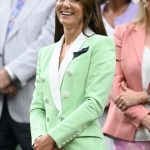Jiab Prachakul would really love to make a portrait of Ocean Vuong. “I discovered him last week in a magazine and I started to read his book ‘On Earth We’re Briefly Gorgeous,’” the 43-year-old artist says from her studio in the walled town of Vannes in Brittany, France. “I was blown away.” A friend suggested that Prachakul contact him on Instagram, but she hates the platform. She got in touch with his team instead, but no response has been forthcoming. “He’s unreachable,” she concludes sorrowfully.
Fortunately, the Thai artist has had plenty of other work to focus on, including two shows this fall: “Rendezvous in Time” opened at Timothy Taylor in New York in September; “Simplicity/Complexity” opens at Micki Meng in San Francisco on October 23. “Rendezvous in Time” explores Prachakul’s life in Vannes, where she enjoys fresh air and expansive skies, unlike in her previous home in Lyon, where the city’s pollution exacerbated her asthma. “There’s no doubt about why all the impressionist artists came to Vannes to paint the landscape—it’s heavenly,” Prachakul says. “And it’s very quiet, so I’m really focused on my artwork.”
Jiab Prachakul, Jeonga (In Nia’s Eyes), 2023
Photo by Neige Thébault
In 2020, Prachakul won the £35,000 BP Portrait Prize at the National Portrait Gallery in London, an incredible achievement for a self-taught artist. “Simplicity/Complexity” focuses on the portraits that have made her name. Leaning against a wall in her studio is a finished painting of O Thongthai, a Bangkok-based jewelry designer whom Prachakul got to know through a friend, before realizing that they had met 16 years prior. Like most of her work, the piece is visually beguiling, demonstrates a huge empathy for its subject, and has an emotional urgency that keeps tugging at your sleeve.
Another canvas is mainly blank when Prachakul shows it to me—she takes about a month to complete a picture and works on one at a time—but it will become a portrait of Sonya Yu, a philanthropist, art collector, and the owner of the Four One Nine art space in San Francisco, where Prachakul had her first show in 2021. Like almost all of her subjects, O Thongthai and Yu are part of the East Asian diaspora. The paintings express Prachakul’s desire to represent her community, but they are also a personal exploration of identity. She is especially interested in the question of what living far from one’s homeland does to one’s sense of self.
Jiab Prachakul, Yasuko, 2020
Photo by Neige Thébault
“You can let your connection to your home country just fade away, and when you go back you’ve got no way to connect anymore,” Prachakul says. “Especially me—I don’t even eat Thai food because I’m allergic to monosodium glutamate. If you can’t appreciate the food from your home country, then who are you really? I see who I am by painting the people I feel related to. Learning about someone else’s life helps me understand my own.”
Prachakul was born in Nakhon Phanom, in northeast Thailand. She studied film at Thammasat University in Bangkok and became a casting director in the Thai movie industry—a job that, like being a portraitist, requires a careful study of human faces and characters. “If you have 50 people coming in for one role, you’re looking for someone who will fit, not because of what they look like but what they are like,” she explains.
After three years in the business, Prachakul moved to London. In 2007, she had an epiphany when she saw a David Hockney retrospective at the National Portrait Gallery. “The first room was about how he started his career—there was a drawing, paintings from high school and university, and then you entered the second room and bam—a masterpiece!” This was the double portrait Mr and Mrs Clark and Percy, which showed, to stunning effect, how fast and far Hockney had been able to push his nascent talent. It also suggested aspirational glamour: “I thought, maybe one day, I could belong in that lovely apartment too.”
Jiab Prachakul, Half Sisters, 2023
Photo by Neige Thébault
Having only drawn in high school before, Prachakul set about teaching herself how to paint, a process that took 14 years. After London, she moved to Berlin, but galleries weren’t interested in representing her, partly because she hadn’t attended a famous (or indeed any) art school, partly because she was painting portraits rather than making films or conceptual art. To make money she sold bags, t-shirts, and backpacks printed with her artwork in the city’s flea market. “The hungry artist who has to make a living, that was me!” Prachakul says. “Just as other artists served their time at university, I served my time in the street market in Berlin.”
The BP prize changed everything, bringing with it gallery representation and commissions (the prize included one from the National Portrait Gallery). Prachakul has now stopped taking commissions, as she felt uncomfortable painting people she didn’t know—“like I’d forced myself to go on a blind date.” She cherishes the fact that Palme d’Or-winning Thai filmmaker Apichatpong Weerasethakul sat for a portrait when she was still unknown. “I wrote him and introduced myself and he answered, ‘Of course I will be honored to be portrayed by you.’ I felt like I’d already won some prize, because I admire his work so greatly.” She adds that his films are subtle but laden with emotion: “That’s something I’m keen to explore, if a painting can be quiet but full of understanding and conversation.”
Jiab Prachakul, Guillaume, 2023
Photo by Neige Thébault
Prachakul’s grand ambition is to get her work in the permanent collections of major museums, and eventually to have a retrospective in one of them. To this end, she works between late morning and 6 PM in her studio (to work later, she says, is “unhealthy”). She then goes for a swim or walk with her husband, who is French and a blockchain architect, and after that watches a movie. The night before we speak, the couple had watched Late Spring (1949) by the Japanese master Yasujirō Ozu—“so touching”—which made Prachakul think about doing a set of paintings about the seasons. She says there’s a through line in her new show, which, in fact, could apply to her work in its entirety. “All of the canvases ultimately aim to convey a form of empathy, a form of human emotion and experience we all share.”



